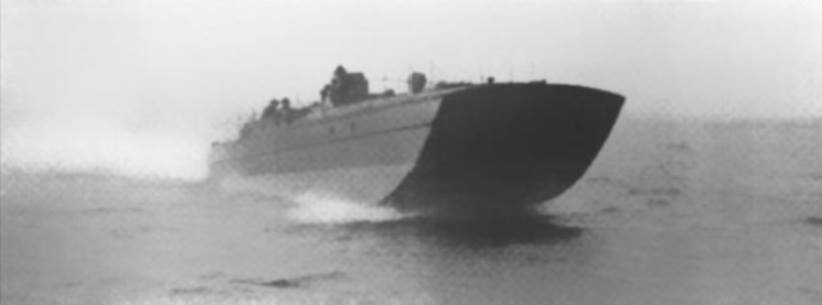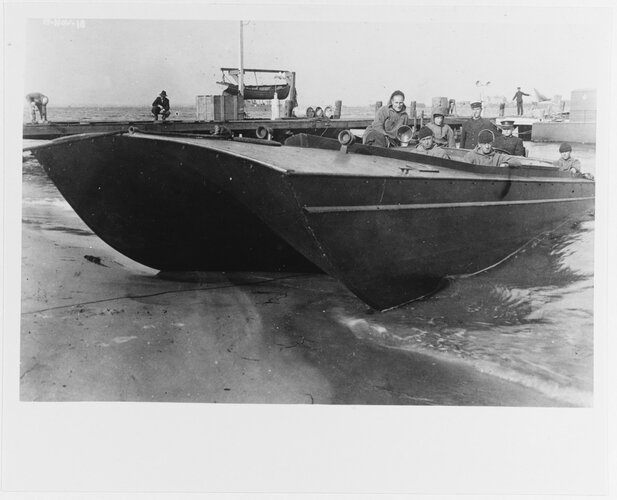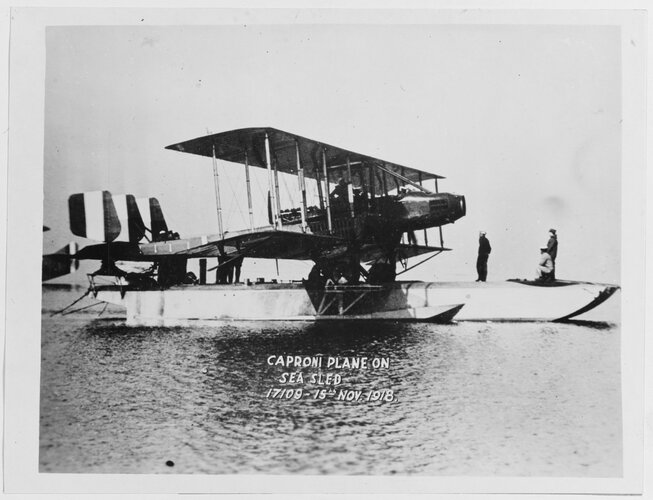You are using an out of date browser. It may not display this or other websites correctly.
You should upgrade or use an alternative browser.
You should upgrade or use an alternative browser.
Hickman Sea Sled torpedo boat
- Thread starter tallguy
- Start date
ArmchairSamurai
ACCESS: Confidential
- Joined
- 1 July 2019
- Messages
- 119
- Reaction score
- 154
Seems to be pretty readily available. I found two sites so far that speak of WW1 use by the US Navy.Looking for info on the torpedo boat version of the Hickman sea sled. Not much out there.
Attachments
ArmchairSamurai
ACCESS: Confidential
- Joined
- 1 July 2019
- Messages
- 119
- Reaction score
- 154
Here is the US Navy concept being put into practice, a Caproni plane being carried by sea-sled to "intercept submarines" as it were. Unfortunately, while the concept was sound, the war ended and nothing came from it.Seems to be pretty readily available. I found two sites so far that speak of WW1 use by the US Navy.Looking for info on the torpedo boat version of the Hickman sea sled. Not much out there.
Attachments
ptdockyard
"Pick out the biggest and commence firing"
- Joined
- 19 January 2014
- Messages
- 113
- Reaction score
- 137
I have read about the sea sled MTB in Friedman's book on Small Combattants. No pictures or drawing of the MTB concept there though.
ArmchairSamurai
ACCESS: Confidential
- Joined
- 1 July 2019
- Messages
- 119
- Reaction score
- 154
I just realized OP said "torpedo boat", somehow someway my mind skipped over that. Oops.
I found this: http://invertedvboats.freeservers.com/Hickman_Bio.html
Not sure if it'll be much help. It talks about the torpedo boat, however, I get the impression it was never built. The British seemed to have built something similar based on Hickman's design: https://en.wikipedia.org/wiki/HM_Coastal_Motor_Boat_4
I found this: http://invertedvboats.freeservers.com/Hickman_Bio.html
Not sure if it'll be much help. It talks about the torpedo boat, however, I get the impression it was never built. The British seemed to have built something similar based on Hickman's design: https://en.wikipedia.org/wiki/HM_Coastal_Motor_Boat_4
A Tentative Fleet Plan
I really should change my personal text
- Joined
- 9 April 2018
- Messages
- 949
- Reaction score
- 1,891
The CMB had a different hull design from Hickman's Sea Sled.Not sure if it'll be much help. It talks about the torpedo boat, however, I get the impression it was never built. The British seemed to have built something similar based on Hickman's design: https://en.wikipedia.org/wiki/HM_Coastal_Motor_Boat_4
The latter has an inverted V-shaped hull with a central tunnel to trap air under the hull to reduce resistance.
The Thornycroft CMBs had a planing hull, with a step amidships. At high speeds the craft rides on a small portion of th hull forward of the step and a small area at the stern to reduce resistance. This offers less resistance than planing hulls at high speeds, but more at low speeds.
ptdockyard
"Pick out the biggest and commence firing"
- Joined
- 19 January 2014
- Messages
- 113
- Reaction score
- 137
I have this in my files listed as the prototype for the Hickman MTB. Not the best photo

This site has a mention:
"In 1918 Hickman built a 50-foot, high speed torpedo boat in an attempt to convince the Allied navies that a small, fast boat with a huge load-carrying potential could wreck havoc among large slow enemy ships in WWI."
I actually make a 1/600 mini of a Sea Sled MTB.

This site has a mention:
History of the IVB
Inverted V Bottom Boats the start of a Revolution Sea Sleds Radical Boat Design IVB Boats PLY Marine Quality 5083 Alloy
invertedvboats.freeservers.com
"In 1918 Hickman built a 50-foot, high speed torpedo boat in an attempt to convince the Allied navies that a small, fast boat with a huge load-carrying potential could wreck havoc among large slow enemy ships in WWI."
I actually make a 1/600 mini of a Sea Sled MTB.
Last edited:
ArmchairSamurai
ACCESS: Confidential
- Joined
- 1 July 2019
- Messages
- 119
- Reaction score
- 154
You're right, but the first link I attached (http://invertedvboats.freeservers.com/Hickman_Bio.html) said as much. I quote "By April 6. 1916, the second modern torpedoboat, or CMB (Coastal Motor Boat), had been launched. It encompassed many principles from Hickman's original presentation to the Admiralty, yet from then on the credit would always be attributed to the three British officers."The CMB had a different hull design from Hickman's Sea Sled.
The latter has an inverted V-shaped hull with a central tunnel to trap air under the hull to reduce resistance.
The Thornycroft CMBs had a planing hull, with a step amidships. At high speeds the craft rides on a small portion of th hull forward of the step and a small area at the stern to reduce resistance. This offers less resistance than planing hulls at high speeds, but more at low speeds.
A Tentative Fleet Plan
I really should change my personal text
- Joined
- 9 April 2018
- Messages
- 949
- Reaction score
- 1,891
It wasn't based off of Hickman's design, and worked in a different manner.You're right, but the first link I attached (http://invertedvboats.freeservers.com/Hickman_Bio.html) said as much. I quote "By April 6. 1916, the second modern torpedoboat, or CMB (Coastal Motor Boat), had been launched. It encompassed many principles from Hickman's original presentation to the Admiralty, yet from then on the credit would always be attributed to the three British officers."
Hickman's principles seem to be putting putting torpedoes on small boats. This was hardly new, ships boats had been planned to be used for such purposes for some time prior to the First World War. Fast planing hulls like those drawn up by Thornycroft combined with internal combustion engines made that possible.
ArmchairSamurai
ACCESS: Confidential
- Joined
- 1 July 2019
- Messages
- 119
- Reaction score
- 154
I know what you mean, I am just pointing out that the site said as much. I agree with you, I hope you know that.It wasn't based off of Hickman's design, and worked in a different manner.
Hickman's principles seem to be putting putting torpedoes on small boats. This was hardly new, ships boats had been planned to be used for such purposes for some time prior to the First World War. Fast planing hulls like those drawn up by Thornycroft combined with internal combustion engines made that possible.
miniribbet
ACCESS: Restricted
- Joined
- 12 December 2023
- Messages
- 1
- Reaction score
- 4
The Admiralty representative at the 38ft (41ft loa) Hickman Sea Sled demonstration in Boston, Mass on 5 January 1916 was Lieutenant G. C. E. Hampden (attached is a drawing I did of this craft). During the demonstration, the boat reached sustained 37 mph through whitecaps and rain squalls, with four 185hp eight-cylinder Van Blerk engines powering four surface piercing propellers. Not actually equipped with the Mark VII Bliss-Levett 18" torpedo (private craft built by Murray & Tregurtha), she was loaded with weight in the bow, simulating a single loaded bow tube. She had an internal steel frame with four lift points that allowed a fully loaded boat to be lifted in and out of the water by a mother ship in the same manner as the old 2nd class TBs. Sea Sleds, properly powered, would easily plane and draw very little water when coupled with the surface piercing propellers. Comparison studies done by George Crouch showed that sea sleds were more efficient through the water compared to other high speed craft. Big issue was the slower turning and tendency to "trip" in turns, so Hickman later came up with the beveled chine shortly after WW1. And then there is the whole "hydroplane" version for launching aircraft, another story. By no means a perfect craft, in my opinion she is worthy of mention when it comes to the development of early high speed motor torpedo boats.


Last edited:
Similar threads
-
-
-
-
-
Kaiser Wilhelm II's Homunculus (and torpedo battleships generally)
- Started by Avimimus
- Replies: 30


